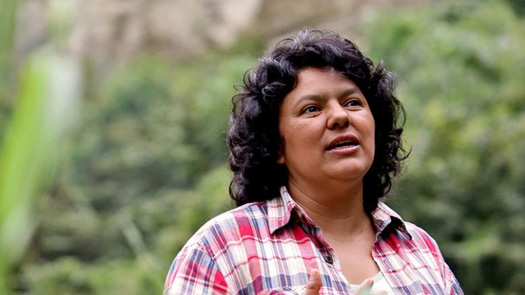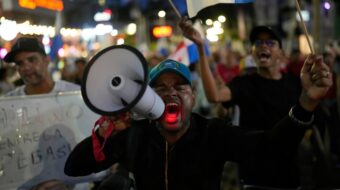
On May 6, five men were arrested for the March 3 murder of Honduran indigenous leader and environmentalist Berta Caceres. Although Caceres’ family and supporters do not see the arrests as bringing closure to the issue, they do reveal a very troubling pattern of multinational corporations, local economic elites and security forces ramping up repression in this impoverished Central American country.
The people arrested include a U.S.-trained, active duty army major, Mariano Díaz Chávez, and a former officer, Edison Duarte Meza. Also accused are Sergio Rodriguez, a community relations official of Desarrollos Energéticos, SA (DESA), the corporation responsible for the Agua Zarca dam project, and Geovanny Bustillo, DESA’s former chief of security. Allegedly Rodriguez and Bustillo may have been the ringleaders of the murder plot. DESA, owned by the Atala family, one of the top clans of the Honduran economic and political elite, has been building the Agua Zarca dam on the Gualcarque River, a project against which Caceres and her organization, COPINH (The Council of indigenous and People’s Organizations of Honduras), had been organizing protests. So both DESA and the Honduran government are directly implicated at the local level. How high in the government the responsibility goes is still not clear. The role of Honduran elites, however, is clear. This is why COPINH and its allies are still calling for an independent international commission to investigate the murder. The arrests came only after an international pressure campaign that caused Dutch, Finnish, Chinese and World Bank funders to back away from financing the dam project.
Shocking, also, is the apparent link of one of the accused, DESA’s Sergio Rodriguez, identified also as an “environmental engineer” to a USAID subcontractor, Fintrac. The Washington D.C. based Fintrac had signed a contract with DESA to channel USAID money to the company in order to carry out minor social aid projects in the area that would be affected by the Agua Zarca dam, such as giving backpacks to local schoolchildren. Caceres and COPINH had complained that this was just a public relations gimmick to make DESA look like a friend of the people, while its dam project was destroying their livelihood and wrecking the physical environment.
The death of Caceres and of another COPINH member, Nelson Noé Garcia, on March 15, as well as many other attacks and threats, has been denounced as part of a return by the Honduran government to the days of the military dictatorship in the 1980s, when a special C.I.A. trained military unit, Battalion 316, caused the death or disappearance of hundreds of Honduran dissidents. The Honduran Human Rights organization CODAFEH, headed by the long time human rights campaigner Bertha Oliva, sees the current wave of repression in Honduras as the continuation of the old Battalion 316’s reign of terror.
Among the demands of COPINH and Berta Caceres’ family has been an end to U.S funding to Honduran security forces, because those forces, including many people trained by the United States, are so heavy involved in the violence against dissidents. In this demand, they are joined by a great number of individuals and organizations around the world, including, in the United States, the AFL-CIO and many members of the U.S. Congress. Many have pointed out that the actions of the U.S. State Department, then headed by Hillary Clinton, after the June 2009 military coup, which overthrew legally elected President Manuel Zelaya, consolidated a coup regime that proved to be both repressive and corrupt, set the stage for the present human rights crisis, and sullied the reputation of the United States in Latin America. Aid to Honduras under present conditions may be a violation of the Leahy Law, which forbids U.S. assistance to foreign security forces which engage in violation of human rights.
However, so far the Obama administration has continued to promote its “Alliance for Prosperity” plan for the “Northern Triangle” of Central American countries, which includes Honduras, El Salvador and
Guatemala. The focus of this plan is to stop the migration from these countries of children and families fleeing desperate situations of poverty and violence and trying to get to family members in the United States. This plan involves continued funding of regional security forces to the tune of hundreds of millions of dollars in spite of the revelations of their complicity in the murder of Caceres and many other acts of brutal violence.
On Friday May 19, U.S. Secretary of Homeland Security Jeh Johnson met with Honduran President Juan Orlando Hernandez to discuss the prevention of undocumented migration of Hondurans to the United States. It appears, though, that Johnson’s visit was entirely focused on preventing migration and human trafficking.
Photo: Berta Caceres. | AP










